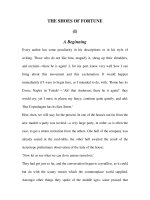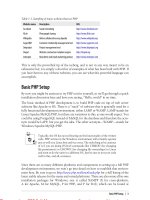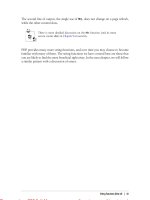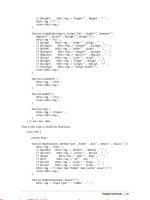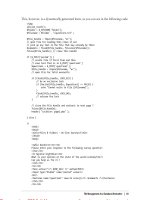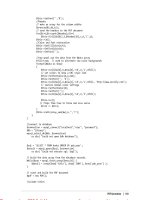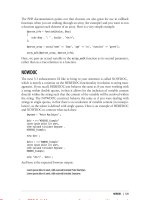The best of wilmott i
Bạn đang xem bản rút gọn của tài liệu. Xem và tải ngay bản đầy đủ của tài liệu tại đây (4.97 MB, 460 trang )
The Best of Wilmott
Volume 1
Incorporating the Quantitative Finance Review
Edited by
Paul Wilmott
The Best of Wilmott
Volume 1
The Best of Wilmott
Volume 1
Incorporating the Quantitative Finance Review
Edited by
Paul Wilmott
Published in 2005 by
John Wiley & Sons Ltd, The Atrium, Southern Gate, Chichester,
West Sussex PO19 8SQ, England
Telephone (+44) 1243 779777
Copyright Wilmott Magazine Ltd 2004
Email (for orders and customer service enquiries):
Visit our Home Page on www.wileyeurope.com or www.wiley.com
All Rights Reserved. No part of this publication may be reproduced, stored in a retrieval system or transmitted in
any form or by any means, electronic, mechanical, photocopying, recording, scanning or otherwise, except under the
terms of the Copyright, Designs and Patents Act 1988 or under the terms of a licence issued by the Copyright
Licensing Agency Ltd, 90 Tottenham Court Road, London W1T 4LP, UK, without the permission in writing of the
Publisher. Requests to the Publisher should be addressed to the Permissions Department, John Wiley & Sons Ltd,
The Atrium, Southern Gate, Chichester, West Sussex PO19 8SQ, England, or emailed to , or
faxed to (+44) 1243 770620.
Designations used by companies to distinguish their products are often claimed as trademarks. All brand names and
product names used in this book are trade names, service marks, trademarks or registered trademarks of their
respective owners. The Publisher is not associated with any product or vendor mentioned in this book.
This publication is designed to provide accurate and authoritative information in regard to the subject matter
covered. It is sold on the understanding that the Publisher is not engaged in rendering professional services. If
professional advice or other expert assistance is required, the services of a competent professional should be sought.
Other Wiley Editorial Offices
John Wiley & Sons Inc., 111 River Street, Hoboken, NJ 07030, USA
Jossey-Bass, 989 Market Street, San Francisco, CA 94103-1741, USA
Wiley-VCH Verlag GmbH, Boschstr. 12, D-69469 Weinheim, Germany
John Wiley & Sons Australia Ltd, 33 Park Road, Milton, Queensland 4064, Australia
John Wiley & Sons (Asia) Pte Ltd, 2 Clementi Loop #02-01, Jin Xing Distripark, Singapore 129809
John Wiley & Sons Canada Ltd, 22 Worcester Road, Etobicoke, Ontario, Canada M9W 1L1
Wiley also publishes its books in a variety of electronic formats. Some content that appears
in print may not be available in electronic books.
British Library Cataloguing in Publication Data
A catalogue record for this book is available from the British Library
ISBN 0-470-02351-1
Typeset in 10/12pt Times by Laserwords Private Limited, Chennai, India
Printed and bound in Great Britain by Antony Rowe Ltd, Chippenham, Wiltshire
This book is printed on acid-free paper responsibly manufactured from sustainable forestry
in which at least two trees are planted for each one used for paper production.
Contents
Introduction
Paul Wilmott
I Education in Quantitative Finance
Riaz Ahmad
II FinancialCAD
Owen Walsh
III Quantitative Finance Review 2003
Dan Tudball
ix
1
5
7
Chapter 1 Rewind
Dan Tudball
11
Chapter 2 In for the Count
Dan Tudball
19
Chapter 3 A Perspective on Quantitative Finance: Models for Beating
the Market
Ed Thorp
Chapter 4 Psychology in Financial Markets
Henri¨ette Prast
Chapter 5 Credit Risk Appraisal: From the Firm Structural Approach
to Modern Probabilistic Methodologies
Hugues E. Pirotte Sp´eder
Chapter 6 Modelling and Measuring Sovereign Credit Risk
Ephraim Clark
33
39
59
69
vi
CONTENTS
Chapter 7 The Equity-to-credit Problem (or the Story of Calibration,
Co-calibration and Re-calibration)
Elie Ayache
79
Chapter 8 Measuring Country Risk as Implied Volatility
Ephraim Clark
109
Chapter 9 Next Generation Models for Convertible Bonds with Credit Risk
E. Ayache, P. A. Forsyth and K. R. Vetzal
117
Chapter 10 First to Default Swaps
Antony Penaud and James Selfe
135
Chapter 11 Taken to the Limit: Simple and Not-so-simple Loan Loss Distributions 143
Philipp J. Sch¨onbucher
Chapter 12 Sovereign Debt Default Risk: Quantifying the (Un)Willingness to Pay
Ephraim Clark
161
Chapter 13 Chord of Association
Aaron Brown
167
Chapter 14 Introducing Variety in Risk Management
Fabrizio Lillo, Rosario N. Mantegna, Jean-Philippe Bouchaud
and Marc Potters
181
Chapter 15 Alternative Large Risks Hedging Strategies
for Options
F. Selmi and Jean-Philippe Bouchaud
191
Chapter 16 On Exercising American Options: The Risk of Making More Money
than You Expected
Hyungsok Ahn and Paul Wilmott
199
Chapter 17 Phi-alpha Optimal Portfolios and Extreme Risk Management
R. Douglas Martin, Svetlozar (Zari) Rachev, and Frederic Siboulet
223
Chapter 18 Managing Smile Risk
Patrick S. Hagan, Deep Kumar, Andrew S. Lesniewski and
Diana E. Woodward
249
Chapter 19 Adjusters: Turning Good Prices into Great Prices
Patrick S. Hagan
297
CONTENTS
vii
Chapter 20 Convexity Conundrums: Pricing CMS Swaps, Caps, and Floors
Patrick S. Hagan
305
Chapter 21 Mind the Cap
Peter J¨ackel
319
Chapter 22 The Art and Science of Curve Building
Owen Walsh
349
Chapter 23 Stochastic Volatility Models: Past, Present and Future
Peter J¨ackel
355
Chapter 24 Cliquet Options and Volatility Models
Paul Wilmott
379
Chapter 25 Long Memory and Regime Shifts in Asset Volatility
Jonathan Kinlay
391
Chapter 26 Heston’s Stochastic Volatility Model: Implementation, Calibration and
Some Extensions
401
Sergei Mikhailov and Ulrich N¨ogel
Chapter 27 Forward-start Options in Stochastic Volatility Models
Vladimir Lucic
413
Chapter 28 Stochastic Volatility and Mean-variance Analysis
Hyungsok Ahn and Paul Wilmott
421
Index
435
Introduction
Paul Wilmott
I
n September 2002 a small, keen group working for a small (but perfectly formed) website,
serving a very niche financial market, joined forces with a book publisher to create a
new magazine, Wilmott, aimed at mathematicians and scientists working in investment
banks. The cunning plan was to bring together cutting-edge content, incisive articles
and fab design; to combine the logic of the research papers for the left-brainers with an
easy-on-the-eye look for the right-brainers. Can’t be done, you say. Well, it can, and it was.
And it struck a chord with quants everywhere.
The backbone of the magazine is the editor, Dan Tudball. But he does far, far more than
just “edit.” He writes, coordinates, plans, sketches, designs . . . his background as an editor of
FHM – not quite a “top-shelf mag” but certainly beyond the reach of the children – ensures
that the appeal of the magazine is not purely cerebral. The legs and arms of the magazine must
be the regular contributors: Aaron Brown, Alan Lewis, Bill Ziemba, Ed Thorp, Espen Haug,
Gustavo Bamberger, Henriette Prast, Kent Osband, Mike Staunton and Rudi Bogni. They give
the magazine its solid foundation, and when necessary grab the readers by the shoulders and
give them a good shaking. The flattering garb would be down to Liam Larkin, our principal
designer. His eye-catching layouts and covers are one of the reasons why magazines tend to
“disappear” – he has unwittingly highlighted the “quant as jackdaw” effect. Graham Russel of
John Wiley & Sons is the eyes and ears of the magazine, monitoring the final product and
liaising with subscribers. Enough with the analogies and body parts already. I must also thank
all of the technical writers. You submitted excellent research material, and by submitting to a
start-up publication you showed great faith in us. Thank you for that faith. This book contains
a selection of the research papers from the magazine’s first year.
As I said, a chord was struck and we have not looked back. A natural development for
a magazine in this field is to run events. We started small with our “Finance Focus” events
in the Financial World Bookshop, London. These are free, open to members of wilmott.com
and magazine subscribers. They now run every month, attracting a crowd of quants for a good
lecture, a spot of casual networking and free food and drink. The success of the Finance Focus
events gave us the confidence to run our first conference, the Quantitative Finance Review
2003. You can read about this event, and then see the write-up of the lectures themselves inside
this book.
E-mail:
x
INTRODUCTION
I would like to thank magazine and event sponsors and advertisers: Algorithmics, BRODA,
Commodity Appointments, d-fine, FinAnalytica, Fleet Search and Selection, GARP, GFI, Harry’s
Bar, Investment Analytics, ITO33, ITWM, London Business School, Millar Associates, Murex,
SciComp, Shepherd Little, Statman Consulting and Wolfram. Special thanks go to Tamara
Jacobs and Owen Walsh of FinancialCAD, who sponsored the Quantitative Finance Review
2003. Owen’s perspective on 2003 and the Review may be read inside.
Finally, I would like to thank our partners in crime, 7city Learning. As well as being Europe’s
most successful financial training company they are also our partners in the Finance Focuses
and the Certificate in Quantitative Finance, and hosted the Quantitative Finance Review 2003.
Thank you, gentlemen, it’s been emotional.
Paul Wilmott
2004
I
Education in
Quantitative Finance
Riaz Ahmad
Quantitative Finance Review 2003
“
Q
uantitative Finance” as a branch of modern banking is one of the fastest growing
areas within the corporate arena. This, together with the sophistication of modern
and complex financial products, has acted as the motivation for new mathematical
models and the subsequent development of mathematical and computational techniques. Investment decisions for predicting risk and return are being increasingly
based on principles taken from the Quantitative Finance arena, providing a challenge for both academics and practitioners. Consequently, a solid command of the fundamentals
and techniques of mathematical finance is essential for a responsible approach to the trading,
asset management, and risk control of complex financial products.
Although relatively young, financial mathematics has developed rapidly into a substantial
body of knowledge. Seventy-three years before the pioneering days of Fischer Black, Myron
Scholes and Robert Merton, Louis Bachelier had derived the price of an option where the share
price movement was modelled by a Wiener process and derived the price of what is now called
a barrier option.
Quantitative Finance encompasses the complete range of pure and applied mathematical
subjects, which include probability and statistics, partial differential equations, mathematical
physics, numerical analysis and operational research. The result has been an extraordinary
number of quantitative-based scientists from a wide variety of backgrounds moving into this
area of research. In addition, the interdisciplinary nature of this subject matter has meant
successful collaborative work being conducted by economists, finance professionals, theoretical
physicists, mathematicians and computer scientists.
Mathematical finance has the attraction of being one of a few areas of mathematics that
plays a central role in current developments in its domain of application. It has a reciprocal
relationship with the “real world” while it both draws from and has direct implications upon
everyday financial practice in the commercial arena. Its numerous applications have become an
integral and visible part of the daily functioning of global financial institutions.
E-mail:
2
THE BEST OF WILMOTT
While there continues to be a great demand for education in quantitative finance, the delivery
of quality-based training in this area remains a premium. An education that is both demanding
in mathematics and related to practice, concurrently, has become a joint concern and a success
factor for both educational bodies and the capital markets. In addressing these concerns, Wilmott
and 7city Learning have created a most successful partnership.
The Certificate in Quantitative Finance (CQF) designed by Dr Paul Wilmott is a six-month
intensive course offering advanced instruction in the mathematical/quantitative methods applied
to investment banking and finance. Delegates (who can also follow the course using the
distance-learning programme) working through weekly problem sheets and monthly exams
further develop these skills. Additional classes in the form of mathematics lectures, tutorials and computer workshops are arranged throughout to further support and complement the
core teaching.
A consequence of delegates returning to mathematics-based education was the need to
offer “refresher-type” courses in calculus, differential equations, linear algebra and probability – giving rise to the Mathematics Primer. These have been extremely popular for prospective CQF delegates who have felt “rusty” due to a long period away from the mathematics learning/application environment. Current plans are to also develop this two/three-day
primer as a separate entity for individuals in industry wishing to take a crash course in basic
mathematics – the type covered in the first term of a university mathematics undergraduate
course.
With increased computing speed and the need for efficient and economical computation in
the financial markets, together with recognizing C++ as the primary mode of technology in
the banking arena, a beginner’s course in C++ was launched. This provides an introduction to
programming concepts with applications to modelling in quantitative finance. Delegates with
no previous background in C++ are taken through the rudiments of this OO-based language
for problem solving in areas such as Monte Carlo and Finite Difference methods and various
other computational techniques of use in derivative pricing.
The year culminated with the Quantitative Finance Review (QFR). This one-day conference, headlined by Ed Thorp and held at 7city’s facility in London, was a meeting designed
for quantitative analysts, by like-minded professionals, to allow speakers and delegates the
opportunity to meet and discuss current ideas in the field of Quantitative Finance. The QFR
managed to draw together many strands, reminding us where we have come from and the need
to always reach for the next innovation – as epitomized by the work of Ed Thorp. It provided
us with a focus on the quandaries surrounding many tools we take for granted, Peter J¨ackel’s
talk on Monte Carlo methods, Aaron Brown’s discussion of the chord of association, Ephraim
Clark’s examination of sovereign issues. And we were also presented with new ways of thinking, behavioural finance being given a showcase through Henriette Prast’s presentation. The
QFR truly represented the trends and currents within this community. Much of the material
presented that memorable day can be found in this volume.
The first formal year of Wilmott and 7city as providers of quality-based mathematical finance
education has been a great success, exceeding by far all initial expectations. It is currently a
very exciting period within the quantitative finance field, no more so than in the education
of such a dynamic area of applicable mathematics. We are looking forward to building on
current programmes and initiatives to further develop the range of both education/training
EDUCATION IN QUANTITATIVE FINANCE
3
related products and finance meetings to continue to offer a superior range of products for the
banking and finance community.
If you are interested in obtaining further information, please contact me on
Dr Riaz Ahmad
CQF Course Director
II
FinancialCAD
Owen Walsh
Quantitative Finance Review 2003
F
inancialCAD Corporation, a leading provider of derivative risk management software
and services, is a proud sponsor of Wilmott magazine and Wilmott events such as the
Quantitative Finance Review, held November 2003. We believe in our partnership
with Wilmott, not only because it is a high calibre magazine that has quickly captured
significant readership in the past year, but because FinancialCAD shares the vision
of Wilmott – encouraging the exchange of ideas between quantitative finance professionals to
facilitate progress in the field.
For those of you not familiar with FinancialCAD, we have built our success on encouraging
an open dialogue with our clients that is fed directly into our products. But it’s not as easy as it
sounds, as meeting our customer’s needs for new or latest industry-proven ways of modelling
and measuring the risk of derivatives takes a consistent and concerted effort. The result, however, is that our industry-standard financial analytics and technology have been helping over
25,000 end-users, during a period of 12 years, add value to their businesses.
Like Wilmott, FinancialCAD also sees its role in the industry as bridging the gap between
financial academics and the financial industry to create the best possible ideas and solutions for
the finance practitioner today. The Quantitative Financial Review 2003 was another example of
the kind of strategic discussion and dialogue that can occur from this exchange of academic and
industry ideas. I left the seminar stimulated by the discussion on credit derivatives modelling,
but my thoughts were quickly overtaken by how I might still be able to profit from Ed Thorp’s
gambling models.
With the world of derivatives in 2003 seeing ever-increasing derivatives transactions in the
market-place, while at the same time, ever-increasing regulations to govern these transactions,
the year 2004 should prove to be interesting.
Now I must finish reading the latest issue of Wilmott!
Cheers!
Owen Walsh
Vice President of Analytics, FinancialCAD
Contact address: VP Analytics, FinancialCAD Corp, 7455, 132nd Street, Suite 100, Surrey BC, Canada V3W 1J8
E-mail: walsh@fincad.com Telephone: 604 507 2763 www.financialCAD.com
III
Quantitative Finance
Review 2003
Dan Tudball
Quantitative Finance Review 2003
The first Wilmott Quantitative Finance review gathered together some of the industry’s
leading lights.
O
n 11 November 2003 the first conference designed for quants by quants took
place in London. Rather than taking the approach of a three-ring circus, which
seems to be the norm these days, the QFR 2003 was designed for a relatively small
number of delegates over the course of one day. The structure of the Review, held
at the headquarters of 7city Learning in the city of London, allowed speakers and
delegates the opportunity to meet and discuss ideas without the clamour of hundreds of vendors
trying to grab your attention. With a special focus on credit derivatives, given the phenomenal
development of the market over the past three years, a stellar group of speakers were gathered
together for what proved to be both enlightening and entertaining presentations. In attendance
to chair the proceedings was Owen Walsh of Fincad, the Canadian-based software company
whose technical perspective on the needs of the market had them ideally placed as platinum
sponsors for the event.
Headlining the event was Ed Thorp, a folk hero of the quantitative finance community. It
is rare to have Thorp speak at such events, and Wilmott was particularly honoured to play host
to this most influential of thinkers. Speakers were drawn from various sectors to provide their
perspective on the year’s activities. Aaron Brown and Henriette Prast are both well known
to readers of this magazine, Philipp Sch¨onbucher, author of what will come to be known as
a seminal work on credit derivatives, Ephraim Clark from the University of Middlesex, Elie
Ayache of ITO33, and Hugues Pirotte Sp´eder from the Solvay Business School, and the Monte
Carlo man himself, Peter J¨ackel.
E-mail:
8
THE BEST OF WILMOTT
Ed Thorp
“Worth the price of admission,” one gushing delegate (who will remain nameless) informed
us after Thorp’s review of his career. The conference could not have started on a better
note, as Thorp discussed his famous cracking of blackjack before taking us through a history of his involvement in the markets, which served to provide those present in the room
with a context which is sometimes overlooked. Thorp’s commitment to scientific advance and
integrity shone through, taking in his work with Sheen Kassouf on warrants in the 1960s,
the setting up of the first market-neutral hedge fund in the early 1970s, his preempting of
the Black–Scholes formula, statistical arbitrage techniques: up–down, industry clusters, factor
models. He wrapped up with some reflections on the current market before being mobbed by
journalists.
Prof Dr Philipp Sch¨onbucher
Currently teaching at ETH in Zurich, Sch¨onbucher has quickly made a name for himself in
the world of credit derivatives theory. His book Credit Derivatives Pricing Models: Models,
Pricing and Implementation has been widely praised as a landmark work in the field. Aside
from a little slapstick work with the LCD projector and some good-natured heckling from Peter
J¨ackel, Sch¨onbucher was able to deliver his paper on portfolio credit risk models for CDs in
relative peace. His discussion took in single tranche products and tracers as hedge instruments.
He examined current benchmarks: Gauss copula, Vasicek model, and remarked on some strange
properties of Gaussian and t-copulae.
Ephraim Clark
Director of Countrymetrics, Clark is the authority on sovereign credit risk. His presentation
provided a fascinating look at how sovereign risk could be more analogous to corporate credit
risk than we might first assume. Despite having rushed up from Paris that morning, Clark
was unruffled and quickly had the audience engrossed. Of particular note was his analysis
of sovereign debt and ratings migrations, new modelling techniques and new techniques for
parameter estimation.
Hugues Pirotte Sp´eder
Responsible for the corporate finance module at the Swiss Accounting Academy, Sp´eder is also
a co-founder of Finmetrics, which specializes in advisory and programming development of risk
management for banks, pension funds and corporate treasuries. Sp´eder’s presentation covered
some of the intricacies currently at play in the credit derivatives market. Sp´eder’s talk covered
the development of technical analysis in credit derivatives from the early days of the first Basel
Accord. Of particular note was his focus on the need for sophistication in this burgeoning area;
stochastic interest rates, firm-exogenous processes, credit risk portfolio creation.
QUANTITATIVE FINANCE REVIEW 2003
9
Aaron Brown
The vice-president of risk architecture at Citigroup was in the unenviable position of bringing
everyone back to earth after lunch. A tough job for even the most accomplished speaker, but
it was difficult not to be engaged by Brown’s fascinating look at ‘association modelling’. In
his usual inimitable style, Brown quickly refuted common misconceptions before turning to
recently available liquid market data in order to discuss how we should account for complex
association in correlation-based trading.
Elie Ayache
Wilmott’s newest columnist is no stranger to the website, where he is numbersix. Ayache’s firm
ITO33 produces cutting-edge convertible bond software. The equity-to-credit problem provided
the focus of Ayache’s talk, which provided a rigorous examination of traditional models, where
equity level determines the intensity of default. Utilizing active spreadsheets and real contracts,
Ayache demonstrated his approach to optimal hedging.
Peter J¨ackel
The man from Monte Carlo was on fine form, having provided a number of belly laughs from
the back of the room. When it came time to step up to the pulpit J¨ackel was well warmed
up. J¨ackel provided an absorbing overview of the past and present approaches in stochastic
volatility modelling before considering future developments in the light of the demands created
by new markets in credit derivatives and increasingly complex instruments.
Henriette Prast
Readers of this magazine are familiar with Dr Prast’s column, “Emotionomics”. Behavioural
finance still produces knee-jerk reactions at the mention of its name; people are either attuned
to it or not. Prast began the final lecture, it seemed, speaking to a room that was roughly
divided on the subject. However, by the end of her exposition of this newest of approaches in
finance, the room seemed converted to her cause, not a hint of cognitive dissonance to be seen.
Covering prospect theory as an alternative to expected utility theory and explaining anomalies
in the financial markets through behavioural perspectives, Prast’s presentation was a fascinating
endnote to the Review.
Papers from the QFR 2003 will be published in 2004.
1
Rewind
Dan Tudball
Wilmott magazine, January 2003
Dan Tudball reviews the major events of the year just gone.
Aaron Brown, Vice President of risk architecture at Citigroup, provides perspective.
“
T
hematic resonance”, that’s what the literati call it; the consistent and thereby
satisfying emergence and re-emergence of the same refrain delivering the moral
and political caution of the work. Explicit, implicit – it matters not; their presence
differentiates art from mere reportage. At this end of the scriptorial spectrum, however, there just isn’t much opportunity to exercise the theme bone on a regular
basis. When it’s actually happening life rarely imitates art; defining moments are by definition not two-a-penny. But occasionally a poor hack is thrown a bone in the shape of an
annual review. There is nothing like the luxury of hindsight to allow a person to discover
“meaning” amidst the ebb and flow of events. Post-rationalization is a cakewalk; ask any
divorce lawyer. So here we are at a new beginning, 2004 still a babe in arms, and 2003 just
so last year and ready to be consigned to history once we’ve neatly summed it up. But a
little like those poor urchins in A Christmas Carol who were disappointed to find that the
giant bird they had masochistically gathered to view in the poulterer’s window each day was
gone, we find there is no discernible theme to bear witness to in the end-of-year shop display.
And no, Ebenezer is not just around the corner to deliver the sweet in swift succession to the
bitter.
The preceding year, 2002, was a gift to theme-hounds. Credit derivatives provided a neat
form of industry closure following Enron, Worldcom and other major defaults. The CD market
was the success story of the year, the new friendly face of derivatives, and the saviour of
many a bank’s potentially embarrassed balance sheet. 2002 ended with a huge collective sigh
of relief, quickly followed by a gasp of awe at how huge the CD market now was. Nice and
tidy. But what of this year just gone? No such luck, sure we may have over-egged the pudding
a little just now – there are worthwhile stories to tell and reflect upon, but the experience has
been somewhat granular.
E-mail:
12
THE BEST OF WILMOTT
Exchanges: Unfinished business
The business of running exchanges has rarely seemed more interesting than this year. Carla Furse
had come to the London Stock Exchange the previous spring only to see a carefully negotiated
merger with Liffe snatched away from her by Euronext. After much speculation, Clara Furse had
been announced Chief Executive of the LSE in 2002. Her coming was trumpeted far and wide as
the beginning of a new age for the exchange, which under her steerage would awake like a giant
from long slumber and stretch its arms to encircle the financial globe. Acquisitions had been the
order of the day and a natural bedfellow surely would be London’s Liffe exchange, and from
there who knew? Unfortunately, Liffe did not share LSE’s views on whose corner it belonged
to and struck a deal with Euronext, the conglomeration of the Dutch, Belgian and French
exchanges. Following this slap in the face, LSE was left sniffing around for another derivatives
partner and lighted upon OM Gruppen, the operator of Sweden’s main exchange in Stockholm.
In January LSE paid a hefty £18.2 million for 76 per cent of OM London Exchange, the
derivatives branch of OM in Britain. Furse was eager to get a slice of the exchange based
derivatives trading market which had, in the preceding four years, seen over 20 per cent growth
in Europe. Statistics like this loom large against a greater than 15 per cent drop in normal
share trading volumes. If anything, 2003 began in much the way it would continue, with the
major themes being consolidation and control. And a certain amount of dragging, kicking
and screaming.
Good times
According to the Bank of International Settlements (BIS), the organized exchanges posted much
stronger six-month growth to June 2003 than the OTC market, with a 61 per cent increase in
notional amounts outstanding (versus 20 per cent in OTC) in the first half of 2003. “This
contrasts with the second half of 2002, when the stock of OTC contracts had increased by 11
per cent whilst the exchanges stagnated. The stronger increase of activity at exchanges occurred
both in the foreign exchange and interest rate segments with exchange-based contracts showing
increases of 42 per cent and 65 per cent, respectively.” LSE’s bugbears, Euronext.liffe and
Eurex, had already made successful plays into the US markets by the end of 2002. LSE had
meanwhile seen an ill-fated partnership with NASDAQ hit the rocks. Eurex began the year livid
with its erstwhile American partner CBOT, with whom the German-Swiss bourse had begun an
electronic trading venture. The Board of Trade had announced, on 9 January, that they would
not be going any further with Eurex after the expiry of their contract at the end of 2003.
Eurex swiftly responded on the same day with the announcement that upon expiry of
that contract it would launch its own American exchange. CBOT had opted to switch to
Euronext.liffe, who promised to match Eurex technology, but on a flat fee basis instead of the
potentially lucrative revenue-sharing arrangement, which Eurex had insisted on. The two European exchanges have shaken things up to some extent in the States. Fully electronic exchanges
expose the inefficiencies and unfairness of open-outcry, making the system look anachronistic.
Dealing spreads tend to be wider in open-outcry, which is great for the exchange who will
be able to profit from larger commissions – and looking at Chicago in particular, where the
three major exchanges are mutually owned by the traders on the floor, it’s no surprise that
open-outcry has lasted so long. They have all had to become hybridized exchanges, providing

